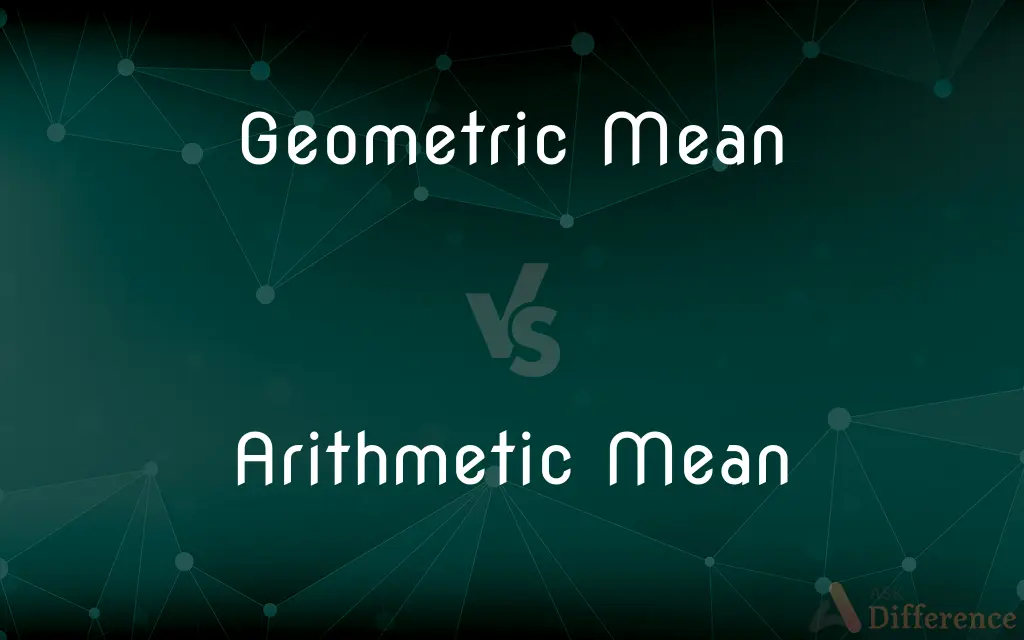Geometric Mean vs. Arithmetic Mean — What's the Difference?
By Tayyaba Rehman — Published on January 4, 2024
Geometric Mean is a type of average found by multiplying all numbers and taking the nth root, often used in growth rates. Arithmetic Mean is the sum of values divided by the count, used in general averaging.

Difference Between Geometric Mean and Arithmetic Mean
Table of Contents
ADVERTISEMENT
Key Differences
The Arithmetic Mean, commonly known as the average, is calculated by adding all the numbers in a data set and then dividing by the number of data points. It is useful for datasets where all values have the same significance. The Geometric Mean, however, is calculated by multiplying all the numbers together and then taking the nth root (where n is the number of data points). It is particularly useful for data that represents rates of change or growth.
Geometric Mean is often used in finance, particularly for calculating average growth rates over time, because it effectively captures the compounding effects. Arithmetic Mean is more widely used in general statistical analysis and everyday calculations where data points are independent and not sequentially related.
One key difference is how each mean handles outlier values. The Arithmetic Mean can be heavily influenced by extreme values, whereas the Geometric Mean tends to dampen the impact of outliers, providing a more middle-ground measure in datasets with wide variance.
In practical applications, Arithmetic Mean is straightforward and easy to comprehend, making it suitable for basic averaging needs. The Geometric Mean, while more complex, gives a better 'typical' value in scenarios like investment returns over time, where you're dealing with multiplicative processes.
Choosing between the two means depends on the nature of the data and what is being measured. Arithmetic Mean is best for additive data, while Geometric Mean is ideal for multiplicative data.
ADVERTISEMENT
Comparison Chart
Calculation
Product of values to the nth root.
Sum of values divided by count.
Use Cases
Growth rates, financial returns, proportional changes.
General averaging, sum-based data analysis.
Sensitivity to Outliers
Less sensitive to extreme values.
More sensitive to outliers.
Represents
Typical value in multiplicative scenarios.
Typical value in additive scenarios.
Suitability
Best for rates of change and compounding effects.
Best for datasets where each value has equal weight.
Compare with Definitions
Geometric Mean
Calculated by multiplying numbers and taking the nth root.
The geometric mean is ideal for calculating average growth rates.
Arithmetic Mean
Can be skewed by outliers in the dataset.
A few high incomes can skew the arithmetic mean in salary data.
Geometric Mean
Represents the central tendency in logarithmic data.
In logarithmic scales, geometric mean is more representative than arithmetic mean.
Arithmetic Mean
Widely used in general statistical analysis.
The survey results were analyzed using the arithmetic mean for simplicity.
Geometric Mean
Often used in financial and economic analyses.
Economists prefer geometric mean for analyzing varying growth rates.
Arithmetic Mean
Represents the sum-based central tendency.
In analyzing household expenses, the arithmetic mean gives a quick average.
Geometric Mean
Less influenced by extreme values in a dataset.
Geometric mean provides a balanced average in datasets with outliers.
Arithmetic Mean
Commonly used for simple averaging in everyday scenarios.
We calculated the arithmetic mean to find the average temperature this week.
Geometric Mean
Effective for datasets with multiplicative relationships.
For annual investment returns, geometric mean gives a realistic average.
Arithmetic Mean
Average found by adding values and dividing by their number.
The arithmetic mean of test scores gives the class's average performance.
Common Curiosities
What is a geometric mean?
It's an average that multiplies all values and takes the nth root.
Why is the geometric mean important in finance?
It accurately represents average growth rates, accounting for compounding.
When should I use the arithmetic mean?
For general averaging when all data points are of equal importance.
Is arithmetic mean affected by extreme values?
Yes, it can be heavily influenced by outliers.
Why might the geometric mean be lower than the arithmetic mean?
It tends to reduce the impact of high outliers.
Can geometric mean handle negative numbers?
No, it's not suitable for negative values.
In which fields is geometric mean commonly used?
In finance, economics, and environmental science.
Does arithmetic mean always represent data accurately?
Not in the presence of significant outliers.
What is an example of using arithmetic mean?
Calculating the average score of a class in a test.
Can I use geometric mean for any type of data?
It's best used for data representing rates of change.
How is geometric mean calculated with two numbers?
Multiply the two numbers and take the square root.
How does data distribution affect geometric mean?
It's more representative in log-normal distributions.
What's a simple definition of arithmetic mean?
It's the sum of values divided by the number of values.
Is geometric mean ever higher than arithmetic mean?
Rarely, usually only in uniformly distributed data.
Can both means give the same result?
Yes, in datasets without significant variation.
Share Your Discovery

Previous Comparison
ALTER Command in SQL vs. UPDATE Command in SQL
Next Comparison
Long Life Milk vs. Fresh MilkAuthor Spotlight
Written by
Tayyaba RehmanTayyaba Rehman is a distinguished writer, currently serving as a primary contributor to askdifference.com. As a researcher in semantics and etymology, Tayyaba's passion for the complexity of languages and their distinctions has found a perfect home on the platform. Tayyaba delves into the intricacies of language, distinguishing between commonly confused words and phrases, thereby providing clarity for readers worldwide.
















































